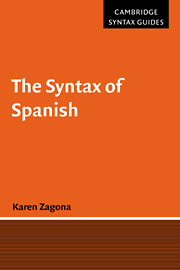1 - Overview of the grammar
Published online by Cambridge University Press: 05 June 2012
Summary
Introduction
The extent of Modern Spanish
Modern Spanish is spoken by just under 300 million people world-wide, and is thus one of the three or four most widely spoken languages, after Mandarin Chinese, English and possibly Hindi. Spanish is the primary or official language in numerous countries, including Spain and its dependencies, Equatorial Guinea, eighteen countries of Central and South America, and the US protectorate of Puerto Rico. Spanish is robust as a first or second language in many areas of the southwestern United States, as well as in other agricultural areas of the US, and urban areas such as Miami and New York. According to the 1990 census, about 17.3 million people over the age of five speak Spanish at home in the US.
Many countries in which Spanish is the official or primary language are linguistically diverse, with bilingualism a common, but not universal, phenomenon. In the north of Spain, primary languages include Basque, Catalan and Galician. In Latin America, many indigenous languages are used alongside Spanish. In Bolivia, for example, at least half the population speaks either Aymara or Quechua natively, and it is estimated that 40% of these speakers do not speak Spanish (Grimes 1988:85–87; Kurian 1992:184). In Paraguay, Guaraní is spoken by over 3 million speakers, with a majority of rural speakers being monolingual (Grimes 1988:125). Relatively large populations of speakers of indigenous languages are also found in Peru (Ayacucho Quechua and Cuzco Quechua), Guatemala (Mayan languages) and Ecuador (Quichua). Many other indigenous languages are spoken, by populations numbering from dozens of speakers to tens of thousands.
- Type
- Chapter
- Information
- The Syntax of Spanish , pp. 1 - 72Publisher: Cambridge University PressPrint publication year: 2001

